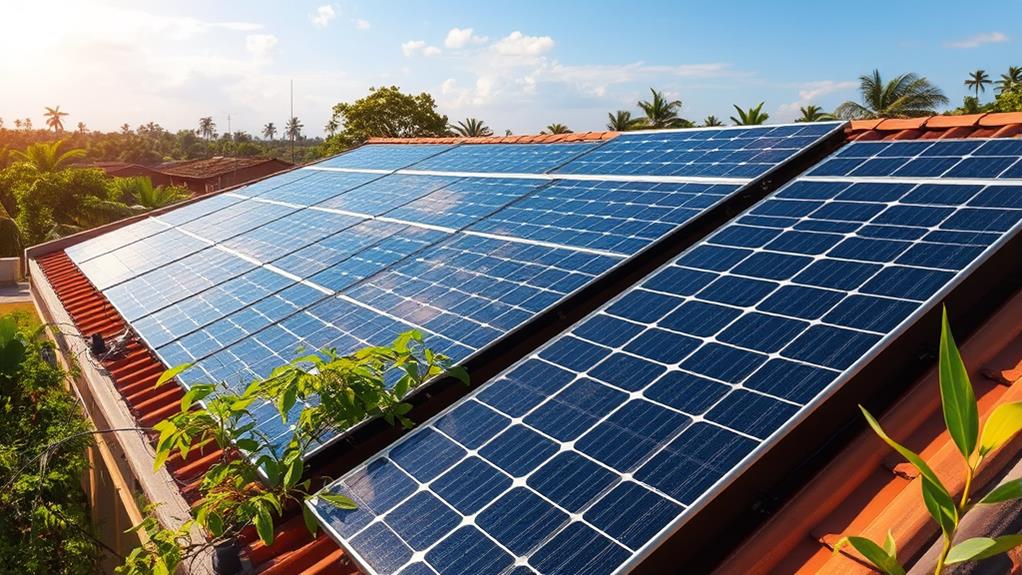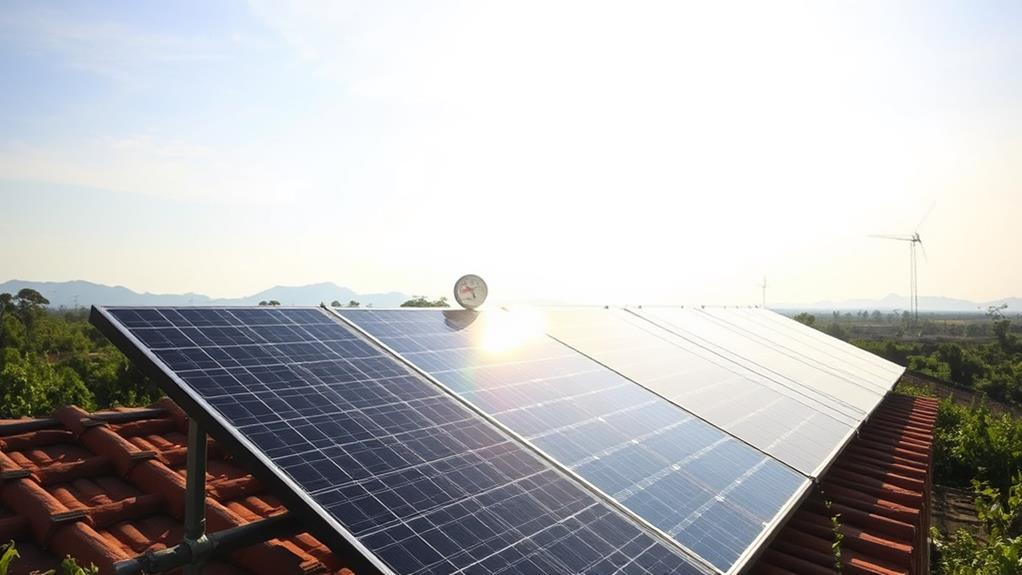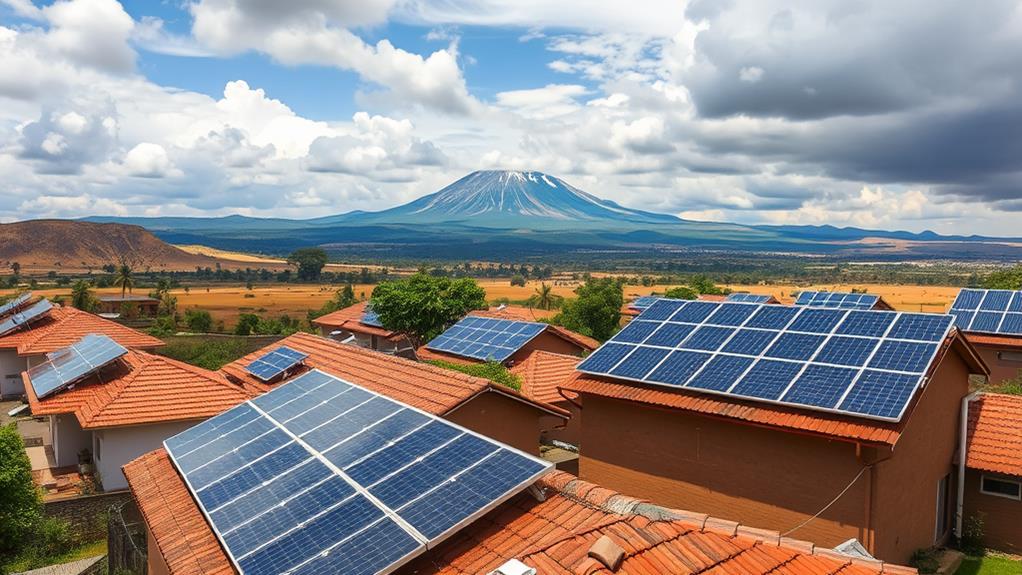You might not know that cold weather can actually boost solar panel efficiency by improving current flow. However, Kenya's highland areas do experience cooler temperatures that could lead to minor performance fluctuations due to thermal contraction and potential micro-cracks in the photovoltaic cells. It's essential to take into account how proper insulation and regular maintenance can mitigate these effects. So, how can you guarantee your solar panels perform at their best even in the chillier regions of Kenya?
Understanding Solar Panel Durability

When evaluating solar panel durability, it's crucial to focus on the materials and construction techniques that contribute to their longevity. Solar panels are typically made from silicon cells, tempered glass, and aluminum frames. Each component plays a critical role in withstanding environmental stressors, including temperature fluctuations.
High-quality batteries for energy storage also enhance the overall reliability of the solar power system.
Silicon cells are efficient at converting sunlight into electricity but can be susceptible to thermal expansion. This phenomenon occurs when materials expand and contract due to temperature changes. High-quality solar panel materials like tempered glass and robust aluminum frames help mitigate this effect.
Tempered glass, for instance, is designed to resist impacts and thermal stress, guaranteeing the silicon cells remain protected.
Construction techniques also matter. For example, encapsulant layers between the glass and silicon cells provide additional protection against moisture and mechanical stress. Proper lamination and sealing methods prevent delamination and water ingress, both of which can compromise panel efficiency and lifespan.
Data shows that panels with superior materials and construction techniques maintain higher performance levels over time. By focusing on these elements, you guarantee your solar investment remains reliable and efficient, giving you the freedom to harness renewable energy without worrying about premature degradation.
Effects of Cold Weather
Effects of Cold Weather
Despite the robust materials and construction techniques that enhance solar panel durability, cold weather poses unique challenges. In Kenya, you might think that cold weather is a non-issue, but certain regions experience significant temperature fluctuations that can affect solar panels. When the temperature drops, the materials in the panels contract. Rapid temperature fluctuations can cause micro-cracks in the photovoltaic cells, leading to a gradual decline in efficiency.
Innovations in solar technology are constantly improving, yet environmental stresses remain a concern.
Frost impact is another concern. Frost can form on the surface of solar panels, creating a barrier that reduces sunlight penetration. Although frost usually melts quickly in the Kenyan sun, repeated freeze-thaw cycles can exacerbate mechanical stress on the panels, further contributing to micro-crack formation.
Moreover, low temperatures can affect the integrity of the panel's mounting system. Metal components can contract, causing bolts and screws to loosen over time. This can lead to misalignment and reduced efficiency of the solar array.
Understanding these effects is vital for maintaining the long-term performance of solar panels. Regular inspections and preventive maintenance can mitigate these issues, ensuring that your investment in solar energy continues to yield ideal returns.
Performance in Cooler Climates

Even though Kenya is known for its warmer climate, performance in cooler regions still warrants consideration for ideal solar panel efficiency. You might be surprised to know that solar panels can actually perform better in cooler temperatures. When temperature decreases, solar efficiency often increases due to reduced thermal resistance in the photovoltaic cells. Data shows that solar panels can maintain up to a 0.5% increase in efficiency for every degree Celsius drop below the standard test conditions of 25°C.
Additionally, the electric fields in solar cells play an essential role in directing electron movement, enabling current flow more effectively in cooler conditions.
However, temperature fluctuations can pose challenges. Rapid changes in temperature can cause expansion and contraction in the materials, potentially leading to microcracks in the cells. Over time, these can reduce overall efficiency.
Additionally, cooler climates might see more cloud cover, impacting the amount of sunlight hitting the panels.
You should also consider the diurnal temperature variation common in Kenya's high-altitude regions. Sharp contrasts between day and night temperatures can lead to condensation issues, which, if unchecked, might affect long-term performance.
Monitoring these fluctuations and understanding their impacts allow you to optimize your solar setup for efficiency, even in cooler parts of Kenya. By keeping an eye on these factors, you guarantee your solar investment remains effective and reliable.
Protective Measures
To guarantee the longevity and efficiency of solar panels in Kenya's varied climate, implementing protective measures is essential. You must prioritize insulation techniques to shield your solar panels from cold temperatures.
Applying proper insulation materials, like ethylene-vinyl acetate (EVA) and tempered glass, can greatly reduce thermal stress, leading to enhanced durability. In addition, utilizing portable solar panels designed for different climate conditions can offer additional flexibility and resilience.
Regular maintenance practices are equally important. Conduct thorough inspections to identify and rectify micro-cracks or delamination issues early. Cleaning the panels' surface guarantees peak sunlight absorption, while systematic checks for moisture intrusion prevent long-term damage and efficiency loss.
Data shows that well-maintained panels can sustain 20% higher efficiency compared to neglected ones.
Investing in advanced monitoring systems can offer real-time data on panel performance, allowing you to promptly address any irregularities. This proactive approach not only prolongs the panels' lifespan but also maximizes energy output, granting you greater independence from conventional energy sources.
Adopting these measures isn't just about preserving your investment; it's about assuring consistent, reliable energy production. By focusing on insulation techniques and diligent maintenance practices, you're empowering yourself with sustainable, efficient energy solutions that align with your pursuit of freedom.
Regional Considerations in Kenya

Kenya's diverse geographical regions present unique challenges and opportunities for solar energy deployment. Understanding the local climate is essential for optimizing energy production. Different regions in Kenya experience varying temperatures, sunlight exposure, and weather patterns, all of which affect solar panel efficiency. Solar energy contributes to a cleaner environment by reducing fossil fuel reliance and enhancing energy independence.
- Highland Areas: Regions like the Central Highlands and Rift Valley experience cooler temperatures and more cloud cover. While cold itself doesn't damage solar panels, reduced sunlight can decrease energy production. Here, installing high-efficiency panels that perform well in low-light conditions is advisable.
- Coastal Regions: Coastal areas, including Mombasa, have higher humidity and moderate temperatures. Salt corrosion from the sea can affect solar panel longevity. You should consider panels with anti-corrosion coatings and regular maintenance to guarantee consistent energy output.
- Arid Zones: Northern Kenya's arid regions, such as Turkana, offer abundant sunlight but face extreme heat and dust. High temperatures might reduce panel efficiency, and dust accumulation can block sunlight. Utilizing self-cleaning panels and proper ventilation can mitigate these issues.
Adapting your solar energy solutions to the specific local climate guarantees maximum efficiency and longevity. By understanding and addressing regional conditions, you're not just investing in solar power but in a reliable and sustainable energy future tailored to Kenya's varied landscapes.
Conclusion
In summary, cold weather doesn't spell doom for solar panels in Kenya. Instead, like a well-tuned engine, they can perform even better with cooler temperatures enhancing efficiency. Regular maintenance and proper insulation are your secret weapons to combat minor fluctuations caused by thermal contraction and potential micro-cracks. So, whether you're in the highlands or other regions, investing in solar panels remains a smart, data-driven choice for sustainable energy in Kenya.
